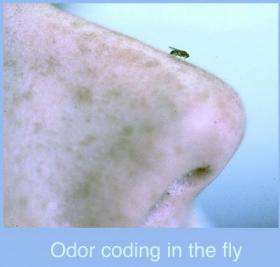How Odors are sensed: A complex system clarified

Yale scientists have systematically plotted the responses of the entire Drosophila (fruit fly) olfactory system, providing the first multi-dimensional map of the range of odorants sensed and the regions of the brain that are stimulated.
John Carlson, the Eugene Higgins Professor of Molecular, Cellular and Developmental Biology and Elissa Hallem, his former graduate student in the Interdepartmental Neuroscience Program, published the comprehensive study in the journal Cell.
"The results of our analysis allow us to make predictions about which odors smell alike to an animal, and which smell different," said Carlson. "These predictions can now be tested in behavioral experiments and may help point us to insect attractants and repellants that are highly effective."
This paper provides particular insight into the understanding of how animals perceive environmental smells that are often complex mixtures of molecular structures. The study identifies compounds that both stimulate and inhibit response in odor neurons, and the differences in response that are due to concentration and duration of exposure to a compound.
"We were surprised to find that inhibitory responses are widespread among odor receptors," said Carlson. "Most receptors are inhibited by at least one odor, and most odors inhibit at least one receptor. Although previous work has been concerned mainly with excitatory responses of receptors, our results suggest that inhibition may play a major role in how odors are identified."
The paper further shows how the responses of the receptor repertoire map into the brain. Surprisingly, receptors with similar odor specificities often map to widely separated locations and receptors with very different specificities often map to neighboring locations.
Carlson and Hallem, who have published extensively in this system over the past several years, found that individual receptors range along a continuum from "narrowly tuned" to "broadly tuned" to odorants. This finding moves the concept of the system beyond the previous picture of a simple dichotomy between specialist and generalist receptors.
Citation: Cell 125: 143-160 (April 7, 2006)
Source: Yale University

















